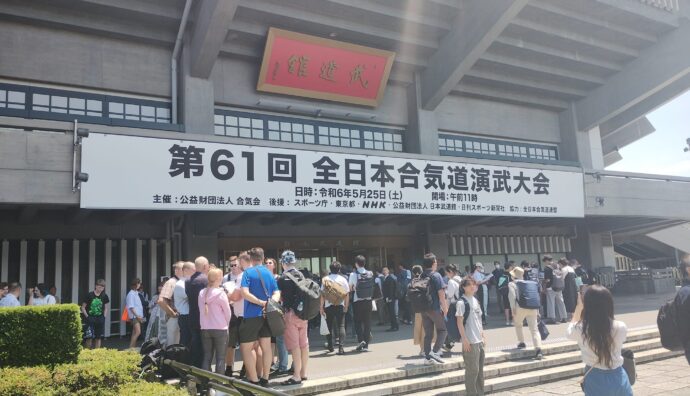The 第61回全日本合気道演武大会, the sixty-first edition of the All Japan Aikido Embukai, was held in recent days.
The history of this event is interesting because it takes us to the years in which the founder of Aikido was still alive. Like all men of that time, Morihei Ueshiba was quite reluctant to show his art in public and therefore public performances took place rarely.
After the end of the Second World War, in 1952 the Japanese people were allowed to officially resume training in the various martial disciplines (which, in fact, had never been interrupted) and so, in 1954 it was Gozo Shioda who represented Aikido at an event organized by Choju Kai.
Given the great success of the event, Morihei Ueshiba’s son, Kisshomaru, understood that the diffusion and popularity of Aikido also and above all depended on events of this kind.
In the spirit of All Japan Aikido Embukai, participants gather to demonstrate their style in front of an increasingly large and involved audience at the Nippon Budokan, in the Chiyoda area of central Tokyo.
An opportunity for meeting and mutual respect and knowledge for the teachers and the expert students who support them. For the audience, the chance of seeing how many branches the tree planted by O’Sensei consists of.
On YouTube and therefore on the various social networks, you can see various performances. There is obviously the Doshu, there is his son, there is the very vital Hiroshi Tada Sensei, there is Seishiro Endo Sensei, Jiro Kimura Sensei and so on…
The best of Japanese Aikido is put on display with the aim of being able to spread the discipline and the values it brings with it.
It is therefore obvious that, on their own pages, everyone republishes the clips of this or that sensei who is the reference of the movement to which they belong. The whole Aikikai world will therefore share the clean lines and the very fast suwari waza of Moriteru Ueshiba and his son Mitsuteru; much of Italian Aikikai will give the right tribute to that exceptional figure that is Tada sensei and so on. Those who follow Endo sensei publish his demo, those who love dynamic skills of Shirakawa sensei will post his clip, those follow another teacher will do the same.
Everyone follows the technical and didactic line in which they are best fit. And this leads to an intimate, often unconscious, belief that the style practiced is objectively better than that of another.
That’s how we are hardwired.
However, we can – and should – learn from the Japanese culture that our style preferences do not prevent us from having a unified vision. That the message that animates the discipline we practice needs to be conveyed to the general audience, because the audience has a great need to understand and transform everyday life for the better and Aikido serves this purpose.
Perhaps we will never have our Nippon Budokan, even if there are noticeable facilities around the world whose purpose is the practice of Martial Arts
Perhaps we will never free ourselves, as Westerners, of our individualistic soul. But we can recover and relaunch the courage to dare, to go into the streets and schools and create moments of meeting with the audience.
Because what is convincing during a demonstration is not just seeing a ninety-year-old moving like a forty-year-old, nor a person who weighs fifty kilos throwing larger people like leaves.
What is convincing is the reason that transpires or does not transpire from the eyes, the atmosphere and the involvement that can be seen in the demonstrations and this requires more authenticity and courage than just republishing a link.
Disclaimer: photo courtesy of Gabriela Conti

